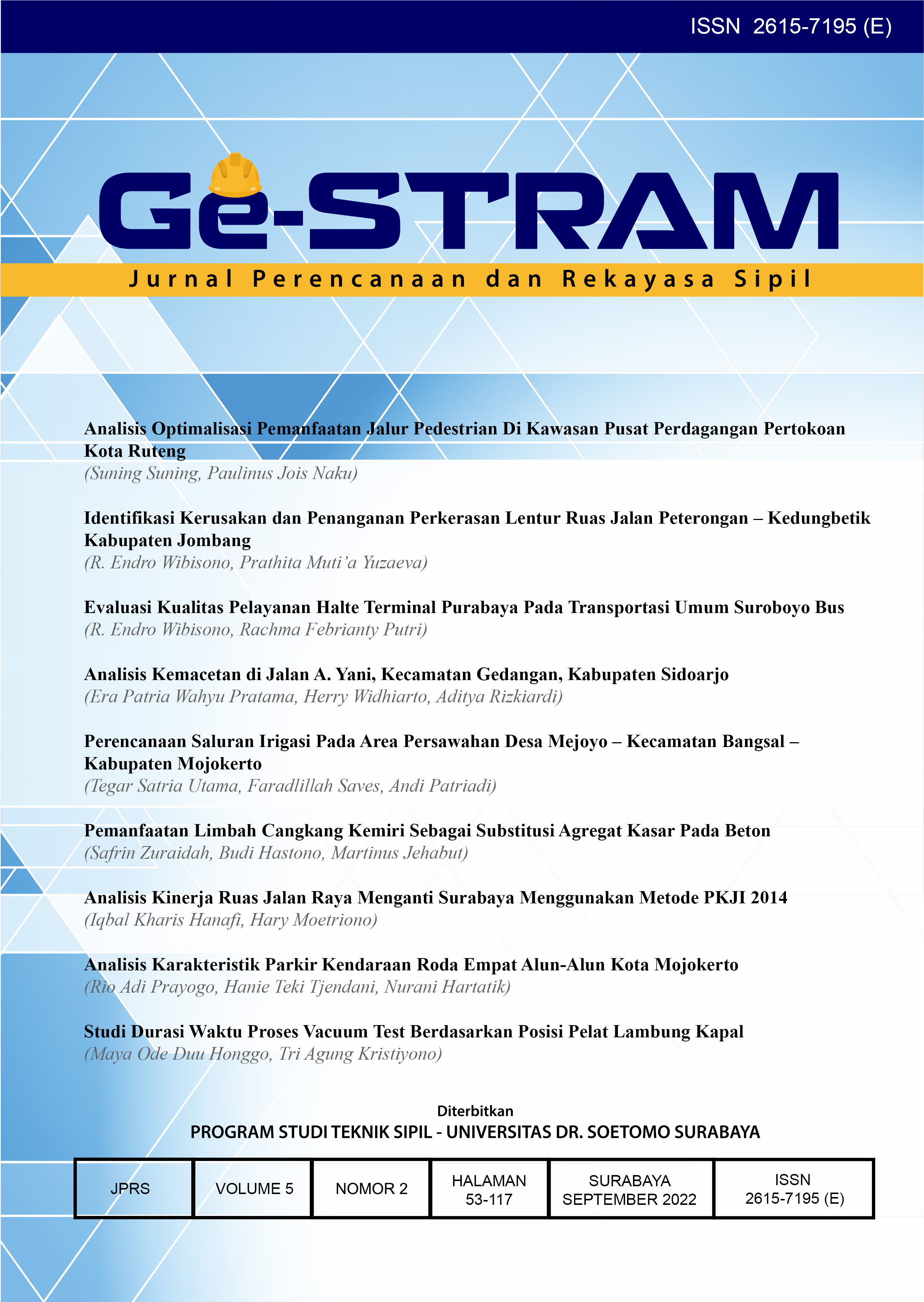Evaluasi Kualitas Pelayanan Halte Terminal Purabaya Pada Transportasi Umum Suroboyo Bus
 Abstract views: 923
,
Abstract views: 923
,
 PDF downloads: 931
PDF downloads: 931
Abstract
Public transportation stops or commonly called bus stops are an integral part of the urban transportation system and part of the transportation infrastructure that is very important and needed by the community to change modes of transportation and reach other public transportation, especially the Purabaya Terminal Stop on the Suroboyo Bus public transportation. Various problems at the Purabaya Terminal stop are inadequate, such as unsafe and uncomfortable seating facilities at the bus stop, the cleanliness of the bus stop is not guaranteed, and the bus stop is not by its function and use because it is used for street vendors, two-wheeled hangouts, and others. The purpose of this observation is to determine the quality of service provided by the Purabaya Terminal Stop on Suroboyo Bus public transportation and to develop a design concept for the Suroboyo Bus stop that is environmentally friendly in the city of Surabaya. Data collection methods were used, namely field observations, literature and literature, documentation methods, and questionnaire methods. The results of this observational analysis are performance level assessment, importance level assessment, suitability level assessment, calculation of the average value of performance level and importance level, Cartesian diagram, and implementation of the IPA (Importance-Performance Analysis) method. With the results of the analysis, it can be concluded that the service quality of the Purabaya Terminal Stop on Suroboyo Bus public transportation is unsatisfactory with the performance level value of all attributes (X) of 2.89 and the importance level of all attributes (Y) of 4.81. Attributes that exist in Quadrant A (Main Priority) should be prioritized and improved so that the performance/implementation is increasing and getting better. The attributes that exist in Quadrant A are the real/physical condition of the lighting at the bus stop (Attribute number 3), the real/physical condition of the information board at the bus stop (Attribute number 4), the condition of the availability of the trash can at the bus stop (Attribute number 5), accessibility/convenience for disabled bus stop users (wheelchair users and so on) (Attribute number 10), and security guarantees from criminal acts for bus stop users (Attribute number 13). The design concept of the environmentally friendly Suroboyo Bus stop in the city of Surabaya by prioritizing the concept of green infrastructure that is environmentally friendly. Then provide facilities at the bus stop such as toilets, trash cans, seats, lighting, shade plants, green lanes (parks), pedestrian/pedestrian paths, shelter information boards, routes, and schedules (timetable) that are good and adequate at each Suroboyo Bus stop in Surabaya City.
References
Andre, Y., & Tileng, K. G. (2019). ”Analisis Kualitas Website Perpustakaan Universitas Ciputra Surabaya Menggunakan Metode Webqual 4.0 dan Importance-Performance Analysis (IPA)”. AITI: Jurnal Teknologi Informasi. Vol.16, No.1, Februari 2019, Hal 49-64, Fakultas Teknologi Informasi Universitas Kristen Satya Wacana.
Badan Pusat Statistik Surabaya. (2021). ”Kota Surabaya Dalam Angka (Surabaya Municipality In Figures) 2021”. BPS Kota Surabaya.
Dirgantara, H B., & Sambodo, A. T. (2015). ”Penerapan Model Importance Performance Analysis dalam Studi Kasus: Analisis Kepuasan Konsumen bhinneka.com”. Jurnal Sains dan Teknologi. Vol.2, No.1, Februari 2015, Hal 52-62, Kabiscentia.
Makbul, M. (2021). ”Metode Pengumpulan Data dan Instrumen Penelitian”. https://osf.io/preprints/svu73/.
Peraturan Walikota Surabaya. ”Kedudukan, Susunan Organisasi, Uraian Tugas dan Fungsi serta Tata Kerja Dinas Perhubungan Kota Surabaya. Nomor 81/2021.
Peraturan Walikota Surabaya. ”Pembentukan dan Susunan Organisasi Unit Pelaksana Teknis Dinas Pengelolaan Transportasi Umum pada Dinas Perhubungan Kota Surabaya. Nomor 130/2021.
Rahmatunnisa, S. N., Utami, A., & Nurhidayat, A. Y. (2021). Probabilitas Perpindahan Penumpang Transportasi Massal Berbasis Rel (Studi Kasus Kereta Api Argo Parahyangan Terhadap Kereta Cepat Jakarta–Bandung). Ge-STRAM: Jurnal Perencanaan Dan Rekayasa Sipil, 4, 91-96.
Retnawati, H. (2016). Analisis Kuantitatif Instrumen Penelitian, Parama Publishing, Yogyakarta.
Santosa, R., Afga, H., & Muryanto, D. (2018). Analisis Dampak Lalu Lintas Pembangunan Gudang Workshop Peti Kemas Terhadap Kinerja Ruas Jl. KH. Syafii Kabupaten Gresik. Ge-STRAM: Jurnal Perencanaan dan Rekayasa Sipil, 1(1), 38-44.
Sintya, I. (2022). ”Tanggung Jawab Perusahaan Bus Trans Metro Pekanbaru (TMP) terhadap Kerugian Pihak Ketiga yang Menjadi Korba Kecelakaan Menurut Undang-Undang Nomor 22 Tahun 2009 tentang Lalu Lintas dan Angkutan Jalan di Kota Pekanbaru”. Doctoral dissertation, Universitas Islam Riau. http://repository.uir.ac.id/id/eprint/11844.
Widayanti, A., Susanti, A., & Wiyono, A. (2016). ”Evaluasi Kualitas Pelayanan Halte dan Pengembangannya di Kota Surabaya untuk Mendukung Terwujudnya Infrastruktur Berwawasan Lingkungan”. Prosding, Seminar Nasional Sains dan Teknologi Terapan, LPMM-ITATS, Oktober, Surabaya.
Wibisono, R. E., Cahyono, M. S. D., & Muhtadi, A. (2019). October. Analysis on calculation of Vehicle Operating Cost (VOC) at Gejayan intersection before and after fly over ring road operation in Yogyakarta. In IOP Conference Series: Earth and Environmental Science (Vol. 340, No. 1, p. 012036). IOP Publishing.
Copyright (c) 2022 R Endro Wibisono, Rachma Febrianty Putri

This work is licensed under a Creative Commons Attribution-ShareAlike 4.0 International License.
Authors who publish with this journal agree to the following terms:
- Authors retain copyright and grant the journal right of first publication with the work simultaneously licensed under a Creative Commons Attribution-ShareAlike 4.0 International License that allows others to share the work with an acknowledgement of the work's authorship and initial publication in this journal.
- Authors are able to enter into separate, additional contractual arrangements for the non-exclusive distribution of the journal's published version of the work (e.g., post it to an institutional repository or publish it in a book), with an acknowledgement of its initial publication in this journal.
- Authors are permitted and encouraged to post their work online (e.g., in institutional repositories or on their website) prior to and during the submission process, as it can lead to productive exchanges, as well as earlier and greater citation of published work (See The Effect of Open Access).

This work is licensed under a Creative Commons Attribution-ShareAlike 4.0 International License.















